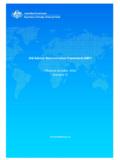Transcription of impact of HIV - who.int
1 The impact of HIV/AIDS on the health workforce in developing countries Linda Tawfik Management Sciences for Health Cambridge, Massachusetts Stephen N. Kinoti Quality Assurance Project (QAP). University Research Co., LLC. Bethesda, Maryland March 2006. Background paper prepared for The world health report 2006 - working together for health World Health Organization 2006. The designations employed and the presentation of the material in this background paper do not imply the expression of any opinion whatsoever on the part of the World Health Organization concerning the legal status of any country, territory, city or area or of its authorities, or concerning the delimitation of its frontiers or boundaries.
2 Dotted lines on maps represent approximate border lines for which there may not yet be full agreement. The mention of specific companies or of certain manufacturers' products does not imply that they are endorsed or recommended by the World Health Organization in preference to others of a similar nature that are not mentioned. Errors and omissions excepted, the names of proprietary products are distinguished by initial capital letters. All reasonable precautions have been taken by the World Health Organization to verify the information contained in this background paper.
3 However, the published material is being distributed without warranty of any kind, either expressed or implied. The responsibility for the interpretation and use of the material lies with the reader. In no event shall the World Health Organization be liable for damages arising from its use. This background paper was commissioned by WHO as background for the World Health Report 2006. The authors alone are responsible for the views expressed, which do not necessarily represent the decisions or the stated policy of the World Health Organization.
4 Table of contents Overview of the impact of HIV/AIDS on the health workforce .. 1. Definition and importance of the health 1. The magnitude of the health workforce crisis .. 1. Why the concern? .. 3. Loss rates by cadre .. 4. Why are health workers absent? .. 4. Unfilled posts in the health sector .. 4. The gender 5. Health system effects of HIV/AIDS .. 5. HIV/AIDS-related morbidity and mortality among health workers .. 8. HIV/AIDS-related morbidity .. 8. HIV/AIDS-related mortality .. 8. Policy implications of morbidity and mortality.
5 9. impact of HIV/AIDS on workforce motivation, performance and migration .. 10. Motivation and 10. Migration .. 11. Attrition of health workers in Africa .. 11. Policy options for the future .. 12. Policy goal .. 13. Current policy gaps and 13. Recommendations for future policy .. 19. Conclusion .. 21. Annex 1. Summary of lessons learnt .. 22. Background to the consultancy .. 22. Methodology .. 22. Initial 22. Recommendations .. 23. List of figures Figure 1. 250-fold variation in supply of doctors among countries, ratio of doctors per 100 000 population.
6 2. Figure 2. 400-fold variation in supply of nurses among countries, ratio of nurses per 100 000 population .. 2. Figure 3. Projection of health workers with AIDS, Botswana .. 3. Figure 4. Reported TB patients in Swaziland, 1991 2004 .. 6. Figure 5. Caseload in Kenyan facilities, 1996, 1999 and 2002 .. 6. Figure 6. Expansion of ART services .. 7. Figure 7. Health worker attrition due to death, Mozambique Ministry of 9. Figure 8. International migration of nurses to the United Kingdom from selected African countries, 1998 11.
7 Figure 9. Attrition of health workforce staff, Kenya, 1996 12. Figure 10. Causes of attrition among health workers in six selected districts, Malawi, 1996 2002 (n=527) .. 12. Figure 11. Improvements in staff satisfaction, Uganda, 2004 .. 18. Figure 12. Improvements in staff performance, Uganda, 2004 .. 18. Overview of the impact of HIV/AIDS on the health workforce This paper addresses one of the key global health challenges today, especially in the poorest countries: the influence of the HIV/AIDS epidemic on the health workforce .
8 First, we provide an overview of the impact of HIV/AIDS on health systems and how this influences demand and supply of the health workforce , with a focus on developing countries. Second, we review the impact of HIVAIDS on morbidity and mortality among staff, with specific emphasis on countries in Africa. Next, we review the impact of HIV/AIDS on workforce motivation, performance and migration. Last, we discuss policy options for future staff scenarios and potential obstacles, highlighting policies that could improve retention, replacement and replenishment of health workers.
9 In fragile health systems, as is the case in most resource-constrained countries, the human resource crisis is the result of many macroeconomic and governance factors. The crisis is further compounded by the impacts of the HIV/AIDS pandemic, which lead to excessive workload and burnout, high worker attrition rates with no replacement and limited entry into the workforce . The solutions to this crisis must therefore include addressing the broader macroeconomic factors as well as the more proximate factors that influence human resource-related functions of the health system.
10 The World health report 2006 provides the first-ever global, regional and country profiles of workers in the health sector and gives new evidence about health worker demographics, as well as recommendations for the future human resource for health development. Our background paper highlights key data and discusses complex and often controversial issues that must be addressed in support of the report's goal. Definition and importance of the health workforce According to WHO, human resources for health (HRH) are the men and women who make health care happen.

















